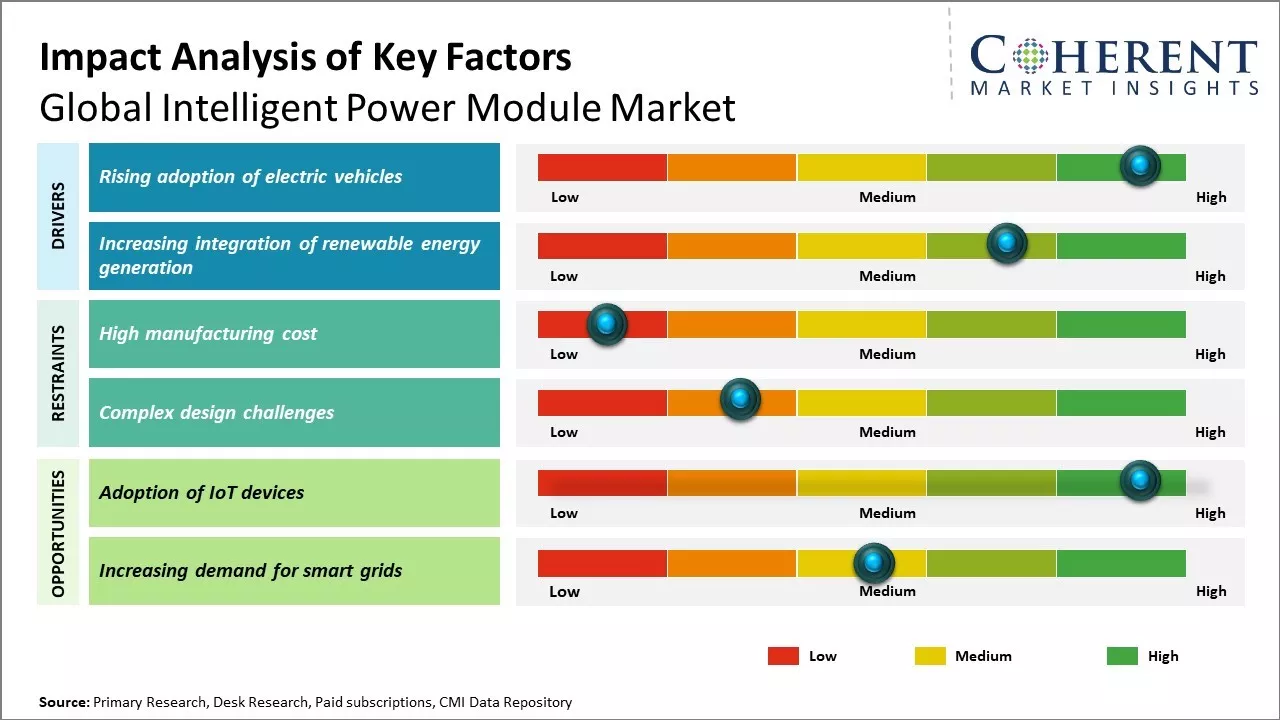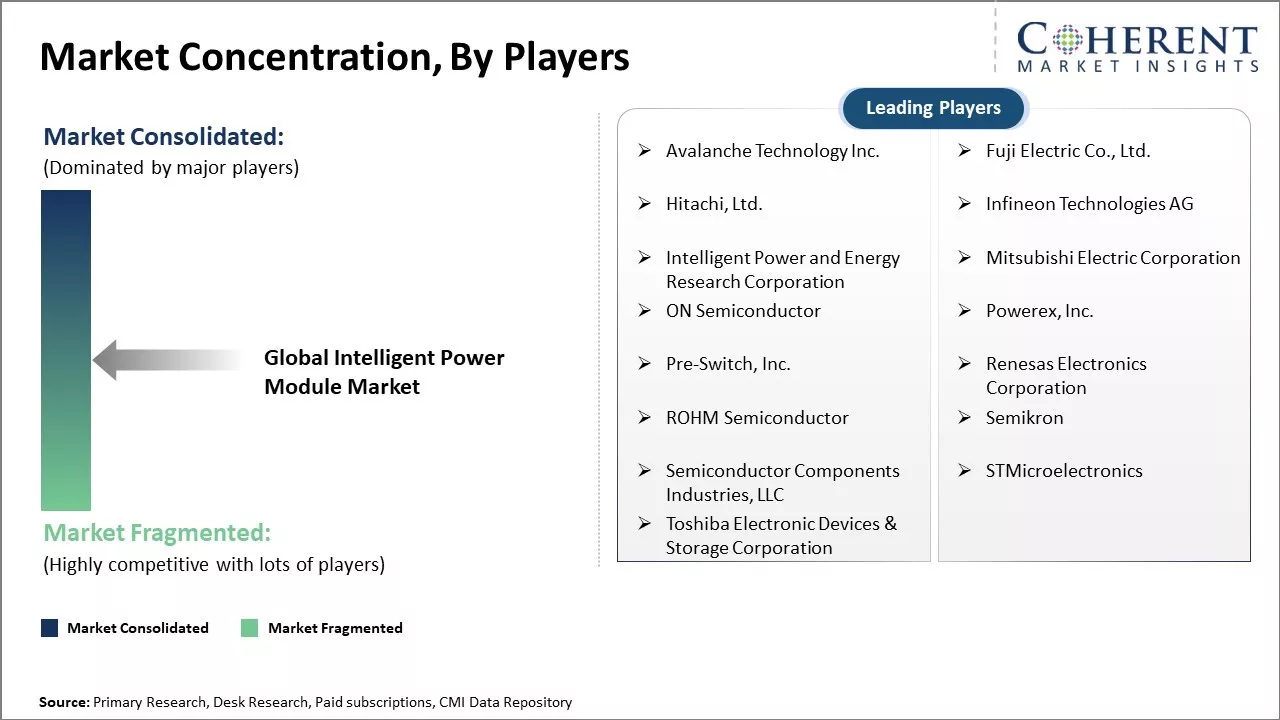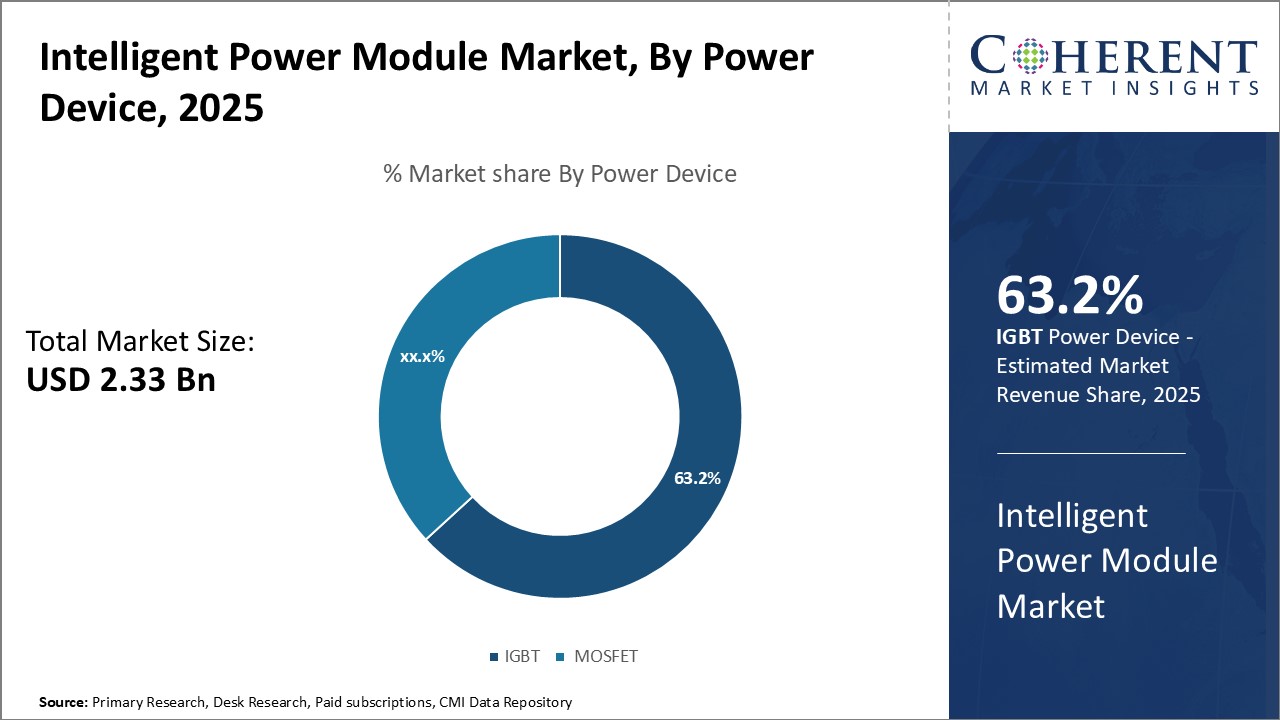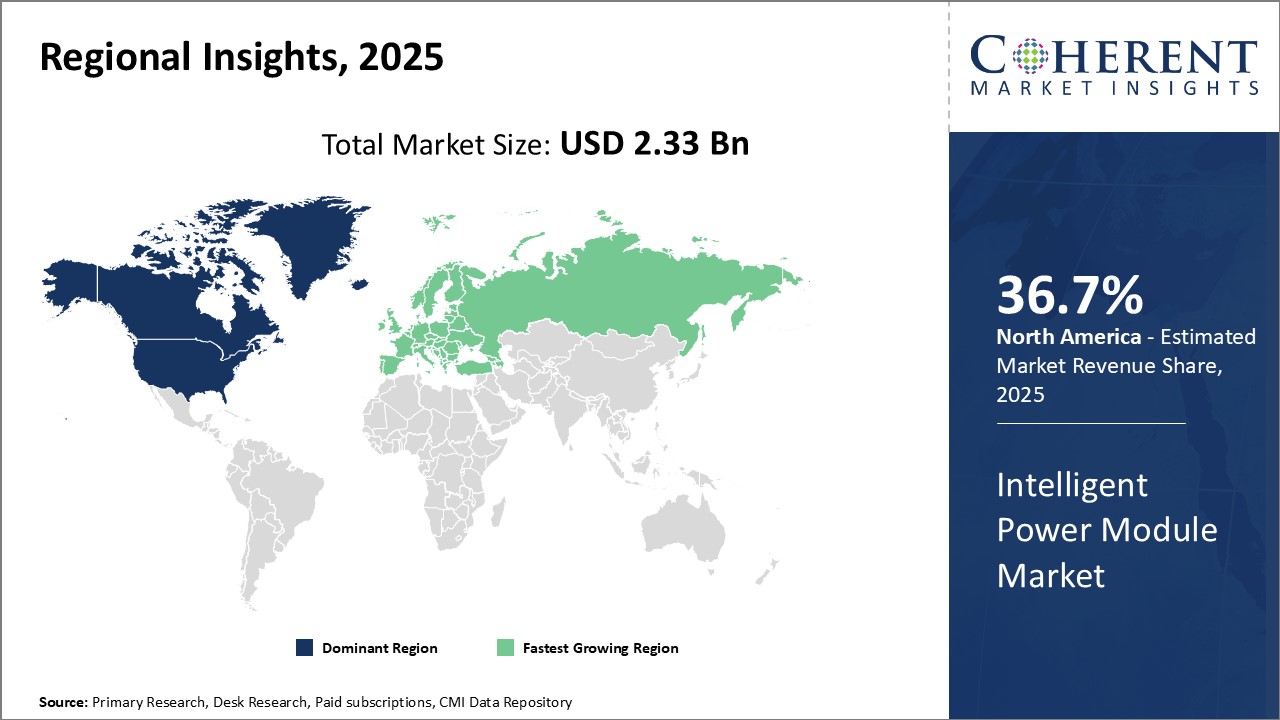Intelligent Power Module Market Size and Trends
The Global Intelligent Power Module Market is estimated to be valued at US$ 2.33 Bn in 2025 and is expected to reach US$ 5.15 Bn by 2032, exhibiting a compound annual growth rate (CAGR) of 12.0% from 2025 to 2032. Intelligent power modules are used in various industrial and automotive applications such as motor drives, power supplies, lighting, consumer electronics, and others. Advancements in electric vehicles and growing adoption of renewable energy are fueling the market growth.

Discover market dynamics shaping the industry: Download Free Sample
The intelligent power module market is poised for substantial growth in the coming years. The primary factors fueling this expansion are the surging demand for electric vehicles and the heightened emphasis on energy efficiency, which are driving the adoption of these advanced power modules.
Furthermore, the rising popularity of consumer electronics and the advancements in renewable energy generation technologies are creating new avenues for intelligent power module providers to capitalize on. These emerging trends are expected to generate significant opportunities for market players to expand their reach and tap into new revenue streams.
Rising adoption of electric vehicles
The automotive industry is witnessing a rapid shift towards electrification. Automakers across the globe are heavily investing in the development of electric vehicles in order to comply with stringent emission norms. Electric vehicles require optimal power electronics control to efficiently manage various functions such as motor control, battery charging, and on-board energy management. Intelligent power modules play a crucial role in electric drivetrains as they allow compact integration and efficient control of high current and high voltage components. The adoption of EVs such as hybrids, plug-in hybrids and full battery EVs is expected to substantially increase in the coming years due to supportive government policies and declining battery prices. This is poised to drive significant demand for advanced intelligent power modules specifically designed for automotive applications. Manufacturers are developing innovative IGBT and MOSFET based IPMs with improved thermal characteristics and high current handling capacity for electric powertrains. The growing electric mobility revolution will remain a key growth driver for the intelligent power module market in the long run.
Market Concentration and Competitive Landscape

Get actionable strategies to beat competition: Download Free Sample
Increasing integration of renewable energy generation
There is growing focus worldwide on integrating more clean and renewable sources into the energy mix to reduce dependence on fossil fuels. This involves substantial investment into solar and wind power projects. Intelligent power modules provide an indispensable solution for effective management and control of power generated from renewable energy resources. They allow optimized maximum power point tracking for solar inverters and energy yield maximization. IPMs are also vital components in utility scale wind turbine drive trains, energy storage solutions and micro-grid applications. The rapid expansion of the global solar and wind power industries has led to increased demand for reliable high-power semiconductors with compact size. The rising energy transition towards renewable sources will continue fostering growth opportunities in the intelligent power module market.
Key Takeaways from Analyst:
Major drivers of the global intelligent power module market include the growing adoption of electric vehicles and increasing penetration of renewable energy sources which is presenting new opportunities for IPM deployment. Rising demand for consumer electronics and home appliances is another key factor propelling this industry forward. However, high initial investment costs associated with integrating IPMs may hinder broader adoption rates in the near-term.
Adoption in industrial sectors and development of IPM offerings with greater power density, higher efficiency, and advanced protections are some of the trends market players are focusing on. The market is witnessing increasing consolidation as well with leading companies looking to enhance portfolio through mergers and acquisitions. Overall, as technologies like EVs, renewable power, and factory automation continue to grow globally, the intelligent power module industry has strong prospects for sustained expansion worldwide.
Market Challenges: High manufacturing cost
High manufacturing cost is one of the major factors restraining the growth of the global intelligent power module market. Intelligent power modules require complex semiconductor fabrication and packaging processes which makes their production quite expensive. These modules typically involve embedding power semiconductors such as insulated-gate bipolar transistor (IGBT), metal–oxide–semiconductor field-effect transistor (MOSFET), and diodes onto a small package along with gate drive and protection circuitry. The assembly procedures include precise die placement, wire bonding, encapsulation and various testing steps which drive up the overall manufacturing costs. Additionally, the use of advanced materials like ceramics and compounds for the substrate and encapsulation further increases expenses.
The capital investment required for setting up a manufacturing line for intelligent power modules is also quite high. Advanced fabrication equipment needed for wafer thinning, dicing, packaging and various backend processes costs millions of dollars. This large initial outlay impacts the economies of scale negatively during the early stages. Furthermore, achieving high production yields during mass manufacturing is challenging given the minute tolerances involved. Even small defects can cause entire modules to be scrapped, reducing margins for the manufacturers. This makes intelligent power modules less profitable to produce until sales volumes cross a certain threshold.
Market Opportunities: Adoption of IoT devices
The widespread adoption of Internet of Things (IoT) devices presents a great opportunity for the global intelligent power module market in the coming years. As more "smart" devices and appliances get connected to the internet, there will be a growing need for power modules that can efficiently and reliably control the power delivery to these networked devices.
IoT deployments are surging across various sectors such as industrial automation, automotive, healthcare, consumer electronics etc. With rising adoption of IoT endpoints, the demand for intelligent power modules featuring advanced power management, enhanced protection and optimized performance will also rise significantly. Most modern IoT devices rely on power modules not just to derive power but also to effectively manage power consumption which is critical to prolong their working life as well as reduce energy costs.

Discover high revenue pocket segments and roadmap to it: Download Free Sample
Insights, By Power Device - Technological Superiority of IGBT Drives Its Market Dominance
In terms of Power Device, the IGBT segment is estimated to hold 63.2% share of the market in 2025 owing to its technological advantages over other devices. IGBTs provide high conduction power capabilities along with fast switching speeds. The high conductivity of intelligent power modules enables them to function efficiently in applications requiring substantial power outputs, such as electric vehicles, industrial motor control systems, and renewable energy conversion equipment. Compared to other power devices like MOSFETs or thyristors, IGBTs (Insulated Gate Bipolar Transistors) experience significantly lower conduction losses, resulting in improved thermal efficiency that allows them to handle significant power loads without overheating.
Additionally, IGBTs can achieve high switching frequencies up to 20 kHz, an operating range well-suited for applications in motor controls and power supplies. Their fast-switching ability minimizes power losses during voltage transitions, thereby improving overall power conversion efficiency. Advancements in IGBT technologies, such as trench gate and field stop structures, have further enhanced their switching speeds.
Manufacturers continue to innovate IGBT chip designs and production processes to maximize device performance, enabling intelligent power modules to deliver higher power densities and lower system costs. The widespread adoption of IGBT intelligent power modules stems from their flexibility across multiple application domains. Manufacturers can tailor IGBT modules to suit the specific voltage and current requirements of diverse loads, leveraging the versatility of IGBTs to develop application-specific modules optimized for electric vehicles, solar inverters, industrial motor controls, welding equipment, and other systems. The availability of IGBT modules in standard and customized package varieties expands their usage potential, giving them a competitive advantage in serving a broad customer base.
Insights, By Voltage Rating - 600 V to 1,199 V Segment Reigns Supreme due to Optimized Design for Mainstream Applications
In terms of Voltage Rating, the 600 V to 1,199 V segment is estimated to hold 41.8% share of the market in 2025 owing to its optimized design for many mainstream applications. The voltage range of 600 V to 1,199 V is well-suited for applications using medium power ratings like motor drives, industrial automation equipment, solar and wind power inversion, and server power supplies.
The 600 V to 1,199 V voltage range provides an ideal balance of conduction and switching capabilities required for controls and power conversion in a variety of industrial processes and systems. Modules in this voltage segment can handle significant power loads effectively without the need for complex circuitry or excessive size and cost overhead. Importantly, voltage ratings in this range do not impose severe conduction or switching losses that higher voltages typically induce.
Moreover, many industrial systems have standardized their designs around 600 V to 1,200 V bus architectures over decades of use, creating an entrenched standards-based approach that provides dependable, proven, and scalable system architectures. This allows system designers to minimize re-engineering efforts and facilitates retrofitting or expanding existing infrastructure. Leveraging the 600 V to 1,199 V module segment, system designers can utilize well-established reference designs and training materials.
Component manufacturers optimize their intelligent power module product lines specifically for this ubiquitous voltage range, enabling customers to benefit from extensive portfolio choices, value-added product features, specialized application support, and other advantages stemming from high market focus. These factors cement the 600 V to 1,199 V segment's market dominance for stable, cost-effective power conversion in many established industrial applications.
Insights, By Application - Automotive segment Drives Surge in Module Adoption
In terms of Application, the automotive segment is estimated to hold 36.3% share in 2025 due to intensive electrification throughout the auto industry. Automakers globally are pouring massive R&D investments into hybrid, plug-in hybrid, battery electric, and fuel cell vehicles. Electrified powertrains represent a strategic priority for the industry's transition to lower emissions and eventually net-zero targets.
Intelligent power modules are a critical enabler for automotive electrification, supporting a wide range of applications such as battery management, electric motor control, DC-DC power conversion, and onboard charging. These modules facilitate the compact and robust integration of high-power semiconductor switches, gate drivers, protection circuits, and control functions.
The functionality of intelligent power modules addresses both the technical and commercial needs of the automotive industry, providing reliable power electronics solutions that can withstand the harsh operating conditions encountered in vehicle applications. By integrating multiple power management components into a single module, manufacturers can simplify system design, improve performance, and enhance the overall reliability of electric and hybrid vehicle power electronics.
As the automotive industry continues its transition towards electrification, the demand for intelligent power modules is expected to grow significantly, as they play a pivotal role in enabling the efficient and reliable operation of various electric powertrain and energy management systems within modern vehicles.
Regional Insights

Need a Different Region or Segment? Download Free Sample
North America has established itself as the dominant region in the global intelligent power module market and is estimated to account for 36.7% share in 2025. The presence of key automotive and industrial electronics manufacturers in the U.S. and Canada drives significant demand. Automobile production in the region is advanced with focus on electric and hybrid vehicles, where intelligent power modules see increasing use. With an emphasis on innovation, many new intelligent power module designs are developed and tested in North American labs before global rollout.
Stringent energy efficiency norms for appliances and equipment also boost the use of intelligent power modules that enable power savings. Tax incentives and funding encourage research on newer technologies using intelligent power modules. North America has emerged as the innovation hub for intelligent power modules. The region also exports intelligent power modules to markets in Asia and Europe.
The Asia Pacific region is witnessing the fastest growth in the intelligent power module market. Surging automobile manufacturing led by China and India is a key driver. As international automakers set up local production bases, the supply chain ecosystem for intelligent power modules is developing at a rapid pace. Growing electronics manufacturing and adoption of renewable energy are additional growth levers.
Countries like South Korea, Taiwan, and Singapore are important design and fabrication centers. This is strengthening Asia Pacific's position in the value chain beyond being the dominant marketplace. Intelligent power modules see increasing export opportunities within the region owing to intra-regional trade agreements and economic corridors. The large price-sensitive consumer base and emerging middle class also makes Asia an attractive market for low-cost intelligent power module designs and applications. With strong annual increases projected across various key parameters, Asia Pacific excluding Japan is emerging as the growth engine for the global intelligent power module landscape in the coming years.
Market Report Scope
Intelligent Power Module Market Report Coverage
| Report Coverage | Details | ||
|---|---|---|---|
| Base Year: | 2024 | Market Size in 2025: | USD 2.33 Bn |
| Historical Data for: | 2020 To 2024 | Forecast Period: | 2025 To 2032 |
| Forecast Period 2025 to 2032 CAGR: | 12.0% | 2032 Value Projection: | USD 5.15 Bn |
| Geographies covered: |
|
||
| Segments covered: |
|
||
| Companies covered: |
Avalanche Technology Inc., Fuji Electric Co., Ltd., Hitachi, Ltd., Infineon Technologies AG, Intelligent Power and Energy Research Corporation, Mitsubishi Electric Corporation, ON Semiconductor, Powerex, Inc., Pre-Switch, Inc., Renesas Electronics Corporation, ROHM Semiconductor, Semikron, Semiconductor Components Industries, LLC, STMicroelectronics, and Toshiba Electronic Devices & Storage Corporation |
||
| Growth Drivers: |
|
||
| Restraints & Challenges: |
|
||
Uncover macros and micros vetted on 75+ parameters: Get instant access to report
Intelligent Power Module Industry News
- In August 2023, Fuji Electric Co., Ltd., a Japanese electrical equipment company, manufacturing pressure transmitters, flowmeters, gas analyzers, controllers, inverters, pumps, generators, ICs, motors, and power equipment announced the launch of the P633C Series, a new generation of compact intelligent power modules. These modules are designed to optimize the power consumption of devices like machine tools and home appliances that they are integrated into, helping to improve the energy efficiency of these applications.
- In July 2023, onsemi, a leading provider of intelligent power and sensing technologies, and Magna, a prominent mobility technology company, announced a long-term supply agreement. Under this agreement, Magna will integrate onsemi's EliteSiC intelligent power solutions into its eDrive systems.
- In May 2022, Sensitron, designed a non-hermetic 40V, 30A radiation tolerant DC load switch module with 100mV/A output current telemetry announced the SPG025N035P1B, a GaN Half Bridge Intelligent Power Module (IPM) that utilizes Efficient Power Conversion's 350 V EPC2050 eGaN FET. By replacing traditional silicon FETs with EPC's 350 V and EPC2050 GaN FETs, Sensitron was able to reduce the size of their solution by 60% while also improving the module's exceptional junction-to-case thermal conduction.
- In February 2022, Infineon Technologies is bolstering its market leadership in power semiconductors by substantially expanding its manufacturing capacity for wide bandgap (SiC and GaN) technologies. The company is investing over US$ 2 billion to build a third module at its Kulim, Malaysia facility. Once this new module reaches full production, it is anticipated to generate an additional US$ 2 billion in annual revenue through the manufacturing of silicon carbide and gallium nitride products.
- In April 2021, Cissoid announced the expansion of its 3-Phase Silicon Carbide (SiC) MOSFET Intelligent Power Module (IPM) product line. The company introduced new liquid-cooled modules specifically designed for e-mobility applications.
- In December 2020, Infineon Technologies AG, designs, develops, manufactures, and markets application-specific ICs introduced the CIPOS Maxi IPM IM828 series, the industry's first 1,200 V transfer-molded silicon carbide (SiC) integrated power module (IPM). This compact inverter solution offers excellent thermal management and a wide range of switching speeds, making it well-suited for three-phase AC motors and permanent magnet motors in variable speed drive applications.
*Definition: The global intelligent power module market consists of intelligent power modules that have integrated functions such as over current, overload, and over voltage protection. These modules help optimize power consumption in various applications such as consumer electronics, automotive, industrial, and communication sectors. They provide fast switching performance while reducing external component count, system cost, and design complexity. The intelligent power modules enhance reliability and efficiency of power electronic systems.
Market Segmentation
- Power Device Insights (Revenue, US$ Bn, 2020 - 2032)
- IGBT
- MOSFET
- Voltage Rating Insights (Revenue, US$ Bn, 2020 - 2032)
- 0 V to 599 V
- 600 V to 1,199 V
- 1,200 V and above
- Application Insights (Revenue, US$ Bn, 2020 - 2032)
- Automotive
- Industrial
- Consumer Electronics
- Energy & Utility
- IT & Telecommunication
- Others
- Regional Insights (Revenue, US$ Bn, 2020 - 2032)
- North America
- U.S.
- Canada
- Latin America
- Brazil
- Argentina
- Mexico
- Rest of Latin America
- Europe
- Germany
- U.K.
- Spain
- France
- Italy
- Russia
- Rest of Europe
- Asia Pacific
- China
- India
- Japan
- Australia
- South Korea
- ASEAN
- Rest of Asia Pacific
- Middle East & Africa
- GCC Countries
- Israel
- South Africa
- Rest of Middle East & Africa
- North America
- Key Players Insights
- Avalanche Technology Inc.
- Fuji Electric Co., Ltd.
- Hitachi, Ltd.
- Infineon Technologies AG
- Intelligent Power and Energy Research Corporation
- Mitsubishi Electric Corporation
- ON Semiconductor
- Powerex, Inc.
- Pre-Switch, Inc.
- Renesas Electronics Corporation
- ROHM Semiconductor
- Semikron
- Semiconductor Components Industries, LLC
- STMicroelectronics
- Toshiba Electronic Devices & Storage Corporation
Share
Share
About Author
As an accomplished Senior Consultant with 7+ years of experience, Pooja Tayade has a proven track record in devising and implementing data and strategy consulting across various industries. She specializes in market research, competitive analysis, primary insights, and market estimation. She excels in strategic advisory, delivering data-driven insights to help clients navigate market complexities, optimize entry strategies, and achieve sustainable growth.
Missing comfort of reading report in your local language? Find your preferred language :
Transform your Strategy with Exclusive Trending Reports :
Frequently Asked Questions
EXISTING CLIENTELE
Joining thousands of companies around the world committed to making the Excellent Business Solutions.
View All Our Clients
